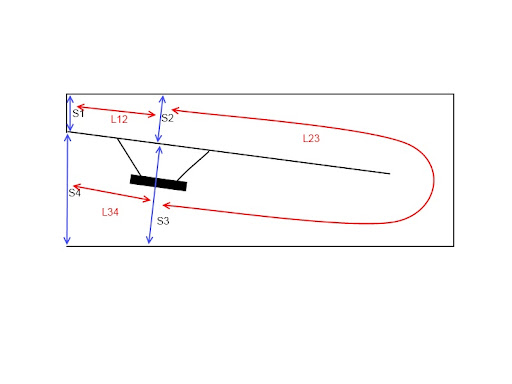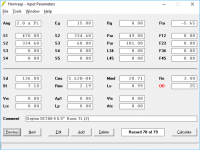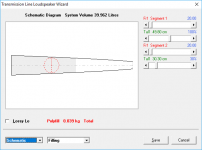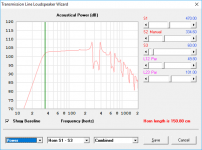I've got 2 pairs (4 drivers total) of Dayton DC160-4 6.5" drivers and a pair of Dayton DC28F-8 tweeters laying around. I'd bought them for a tower build, but am realizing that that design is (a) playing on the border of mltl physics rather than ported and (b) has pretty crappy workmanship so far, so I'm considering bailing on it and using the drivers to make my first t line.
I'm considering a TL because I'm understanding that they generally provide better SQ, volume, and extension over a ported/sealed box at the cost of size and weight. Given that they'd be in a tower format and pretty much left in one spot (either computer or HT), I don't mind making a taller/heavier speaker.
I'm just getting started on my TL research, but I'd just like to ask right off the bat what sort of results I could expect from these drivers in terms of SQ (flatness), SPL (don't need anything too crazy - 110dB should be way plenty), and extension (as low as reasonably possible) and if they would play well with TL at all.
Basically, my question is, for those of you with TL experience, how should I set my expectations, and goals for this potential build given these drivers? I realize I'm doing that a little backwards, but I'm just trying to figure out if a TL is a good candidate for these drivers I've got laying around or not. Checking out the graphs, it looks like I'd be running an XO point around 1,300-1,500 or so, so there would be a good deal of mids coming from them as well. Pro tips are appreciated!
I'm considering a TL because I'm understanding that they generally provide better SQ, volume, and extension over a ported/sealed box at the cost of size and weight. Given that they'd be in a tower format and pretty much left in one spot (either computer or HT), I don't mind making a taller/heavier speaker.
I'm just getting started on my TL research, but I'd just like to ask right off the bat what sort of results I could expect from these drivers in terms of SQ (flatness), SPL (don't need anything too crazy - 110dB should be way plenty), and extension (as low as reasonably possible) and if they would play well with TL at all.
Basically, my question is, for those of you with TL experience, how should I set my expectations, and goals for this potential build given these drivers? I realize I'm doing that a little backwards, but I'm just trying to figure out if a TL is a good candidate for these drivers I've got laying around or not. Checking out the graphs, it looks like I'd be running an XO point around 1,300-1,500 or so, so there would be a good deal of mids coming from them as well. Pro tips are appreciated!
Really?! It's just an elongated reflex, though for the novice, easily designed in Hornresp's Loudspeaker Wizard [LW]. TLs OTOH requires a bit more knowledge, experience and/or the LW or similar horn design software.
Anyway, WTW or TWW and desired tweeter/floor height? Any specific H, W, D dimensions desired or limitations?
GM
Anyway, WTW or TWW and desired tweeter/floor height? Any specific H, W, D dimensions desired or limitations?
GM
Yeah, they're relatively easy to build, but since the terminus is dependent on standing waves to work properly, just a millimeter change in the drivers and/or terminus can have a tremendous impact on sound. If Hornresp handles that stuff too, I'll have to download it and take it for a spin to see what I can come up with.
No real concrete rules just yet. I'd originally gone WTW for my BR, but I'm not opposed to WWT setup. I get the general feeling that TL and MLTL work better the closer the drivers are together, but I'm not sure if that's actually true or not. In my head, I'm imagining the center of the drivers to be roughly between 2.5 - 3.5 feet off the ground. Most of these speakers will be heard from a sitting position, but I may bring them outside, or something on occasion.
No real concrete rules just yet. I'd originally gone WTW for my BR, but I'm not opposed to WWT setup. I get the general feeling that TL and MLTL work better the closer the drivers are together, but I'm not sure if that's actually true or not. In my head, I'm imagining the center of the drivers to be roughly between 2.5 - 3.5 feet off the ground. Most of these speakers will be heard from a sitting position, but I may bring them outside, or something on occasion.
Those drivers look good for a TL. You just have to decide how low you want that TL to go. Here's a two-driver example that goes to 35 Hz. It will likely have to be fine-tuned, but the position of the drivers in the sim suggests that it should be possible to convert this to an actual build using one fold with the drivers located near the top and the vent at the bottom of the enclosure (facing the bottom, or backwards). Particle velocity at the vent is a bit high, but it might be possible to address that by fine-tuning the sim
Attachments
Thanks for the quick sim and screenshot of the TS page! Having never fiddled with Hornresp, that'll help out a bunch!
Personally, my minimum extension requirement for any speaker I make is an f3 of at least 38Hz, but the lower the better. I know for a BR box, a lower than ideal tuning means a bigger box and a significant dip above the tuning frequency. I've not done enough research to know what tuning a TL lower than ideal would sacrifice.
Personally, my minimum extension requirement for any speaker I make is an f3 of at least 38Hz, but the lower the better. I know for a BR box, a lower than ideal tuning means a bigger box and a significant dip above the tuning frequency. I've not done enough research to know what tuning a TL lower than ideal would sacrifice.
So, I've gotten my Hornresp sim to look like yours by trucking through a tutorial and plugging in all the data myself. I'm starting to get it figured out, but I'm still pretty fuzzy on S1, S2, S3, etc params. I get they're horn segment throat, mouth, etc areas, but I'm still trying to get it straight what goes where and why. If there's a quick and easy visual somewhere, that would be super helpful.
The other thing I'm concerned about is, if I'm using this driver up to ~1.5kHz, the midrange looks awfully jagged presumably from the resonances of the line. Stuffing should help, but that's a lot of stuffing. Is this jaggedness some sort of sim quirk to be ignored, or will my low-midrange sound awful in this alignment as the sim suggests?
The other thing I'm concerned about is, if I'm using this driver up to ~1.5kHz, the midrange looks awfully jagged presumably from the resonances of the line. Stuffing should help, but that's a lot of stuffing. Is this jaggedness some sort of sim quirk to be ignored, or will my low-midrange sound awful in this alignment as the sim suggests?
Last edited:
Your tutorial didn't have any pics? That would be odd, unless photobucket stole them. Here's an image.

That's obviously a tapped horn but it's the same thing as tl - just picture the driver on the front of the cab instead of the middle baffle board and nothing else changes. Also don't let the fold trip you up, you could redraw it as a straight line and nothing changes.
It comes from a decent tutorial found here - Simple Tapped Horn Tutorial using Hornresp - AVS Forum | Home Theater Discussions And Reviews
Transmission lines have resonances, that's life. A bit of stuffing will help but I assume Brian already played with the driver location so that's as good as it's going to get unless you close up the open end and use an offset port. You can sim that with TL.app (which is not available at it's original location but apparently is still available if you search for it).

That's obviously a tapped horn but it's the same thing as tl - just picture the driver on the front of the cab instead of the middle baffle board and nothing else changes. Also don't let the fold trip you up, you could redraw it as a straight line and nothing changes.
It comes from a decent tutorial found here - Simple Tapped Horn Tutorial using Hornresp - AVS Forum | Home Theater Discussions And Reviews
Transmission lines have resonances, that's life. A bit of stuffing will help but I assume Brian already played with the driver location so that's as good as it's going to get unless you close up the open end and use an offset port. You can sim that with TL.app (which is not available at it's original location but apparently is still available if you search for it).
- Status
- This old topic is closed. If you want to reopen this topic, contact a moderator using the "Report Post" button.
- Home
- Loudspeakers
- Subwoofers
- What can I expect by dropping these in a T line?


